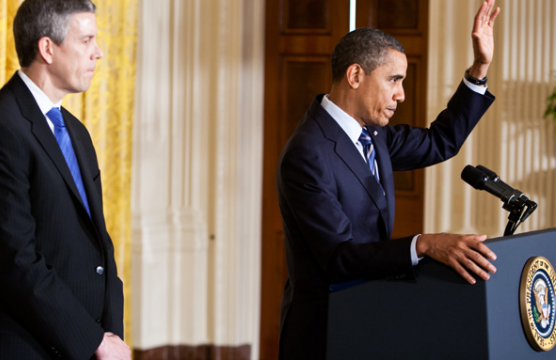
Programas pioneros del liderazgo escolar
View in english Nos complace compartir con Uds. la edición No. 37 de la Serie Mejores Prácticas, “Formación de liderazgo escolar: programas pioneros en Estados Unidos”.
Compartimos un artículo reciente sobre el impacto que escuelas de calidad pueden tener ante el reto de la pobreza. El artículo fue escrito por tres educadores destacados de los EEUU: Joel Klein, encargado de New York City Public Schools; Michael Lomax, presidente del United Negro College fund; y Janet Murguía, presidenta del National Council of La Raza. El artículo emite un mensaje sencillo: que estudiantes pobres pueden aprender de maestros y centros escolares de calidad. El argumento de que las escuelas no pueden superar el impacto negativo de la pobreza por si mismas ha sido popular en los EEUU. Sin embargo, Klein, Lomax y Murguia sugieren que este argumento no sea siempre válido – no solo porque representa un reto demasiado grande y a largo plazo, sino porque existen datos sobre el impacto de pedagogía efectiva en escuelas pobres que indican lo contrario. En síntesis, los autores sugieren que los que quisieran reformar la educación miren hacia adentro y no solo hacia afuera para las soluciones.
Dicen: “Los que defienden nuestro fracaso educativo dicen que nunca arreglaremos la educación en nuestro país hasta que erradiquemos la pobreza. Lo tienen al revés. Nunca erradicaremos la pobreza hasta que arreglemos la educación. La pregunta es si tenemos la voluntad política para enfrentar a los que favorecen el estatus que sirve a muchos adultos pero afecta a muchos niños.”
Los autores también co-dirigen la junta directiva del Education Equality Project (EEP), una iniciativa de alto nivel que inició en 2008 para enfrentar la brecha racial en las escuelas de los EEUU.
Why great teachers matter to low-income students
By Joel I. Klein, Michael Lomax and Janet Murguía
Friday, April 9, 2010; A19
In the debate over how to fix American public education, many believe that schools alone cannot overcome the impact that economic disadvantage has on a child, that life outcomes are fixed by poverty and family circumstances, and that education doesn’t work until other problems are solved.
This theory is, in some ways, comforting for educators. After all, if schools make only a marginal difference, we can stop faulting ourselves for failing to make them work well for millions of children. It follows that we can stop working to reauthorize the Elementary and Secondary Education Act (currently known as No Child Left Behind) and stop competing in the Obama administration’s Race to the Top initiative, which promises controversial changes.
Problem is, the theory is wrong. It’s hard to know how wrong — because we haven’t yet tried to make the changes that would tell us — but plenty of evidence demonstrates that schools can make an enormous difference despite the challenges presented by poverty and family background.
Consider the latest national math scores of fourth- and eighth-graders, which show startling differences among results for low-income African American students in different cities. In Boston, Charlotte, New York and Houston, these fourth-graders scored 20 to 30 points higher than students in the same socioeconomic group in Detroit, Milwaukee, Los Angeles and the District of Columbia. Boston fourth-graders outscored those in Detroit by 33 points. Ten points approximates one year’s worth of learning on these national tests, which means that by fourth grade, poor African American children in Detroit are already three grades behind their peers in Boston.
Not surprisingly, these differences persist (or grow) by the eighth grade, at which point low-income African American students in Detroit are scoring 36 points behind their peers in Austin.
The scores tell a similarly painful story for low-income Hispanic students in different cities. In fourth grade, there is a 29-point difference between test scores in Miami-Dade and Detroit. By eighth grade, the gap has closed slightly, with low-income Hispanic students in Houston outscoring their peers in Cleveland and Fresno, Calif., by 23 points.
These numbers represent vast differences in millions of lives. Low-income African American and Hispanic students in different cities are sufficiently similar in terms of their academic needs, but their outcomes are so dramatically different.
The main difference between these children is that they are enrolled in different school districts. And research indicates that if the data were broken out for the same students in different schools, the differences would be more dramatic — and more dramatic still if broken out for the same children in different classes.
What explains these differences? Schools and teachers. «Teacher quality is the single most important school factor in student success,» the Aspen Institute’s Commission on No Child Left Behind recently noted. Given how much research supports this view, it is especially troubling, the commission found, that «teacher quality is inequitably distributed in schools, and the students with the greatest needs tend to have access to the least qualified and least effective teachers.»
Different teachers get very different results with similar students. So as reauthorization of the Elementary and Secondary Education Act is considered, we should look closely at those whom we attract and retain to teach, with regard to their quality and to ensuring that they are distributed equally across our school districts. If we can do those things, we could at least make Detroit students perform like those in Boston, and make Boston students do a lot better.
A few things need to happen:
First, we must attract teachers who performed well in college. Countries that do best on international tests draw teachers from the top third of college graduates. In the United States, however, most teachers come from the bottom third. Moreover, the bottom of that group is vastly overrepresented in our highest-needs communities.
Second, we must create systems that reward excellence rather than seniority by creating sophisticated evaluation systems that include student performance and merit-based tenure and compensation. We must make it easier to remove teachers who are shown to be ineffective.
Third, we must do more to attract teachers to high-needs students, schools and subject areas, such as English language learners, special education and other areas to which it is difficult to draw talent because of opportunities in other fields.
These are common-sense and ambitious reforms. Such efforts are rewarded in the Race to the Top initiative and ought to be fully integrated into a new Elementary and Secondary Education Act. Yes, they call for a reevaluation of seniority — the staple of most collective bargaining agreements — in the context of what actually serves children. But right now, one bad teacher with seniority earns as much as two great young teachers. Who really thinks this is best for our kids?
Apologists for our educational failure say that we will never fix education in America until we eradicate poverty. They have it exactly backward: We will never eradicate poverty until we fix education. The question is whether we have the political courage to take on those who defend a status quo that serves many adults but fails many children.
Joel I. Klein is chancellor of New York City schools. Michael L. Lomax is president and chief executive of the United Negro College Fund. Janet Murguía is president and chief executive of the National Council of La Raza. They are co-chairs of the Board of the Education Equality Project.
View in english Nos complace compartir con Uds. la edición No. 37 de la Serie Mejores Prácticas, “Formación de liderazgo escolar: programas pioneros en Estados Unidos”.
El pasado viernes, el Presidente Obama concedió más flexibilidad a los estados que están luchando para cumplir con los requerimientos de la ley “No Child Left Behind” (Que ningún niño se quede atrás, NCLB), la cual ha guiado las políticas educacionales de los Estados Unidos desde su aprobación en 2002.
Los Estados Unidos no va por buen camino en sus esfuerzos para mejorar considerablemente su sistema educativo, según un nuevo informe del National Center on Education and the Economy (Centro Nacional de Educación y la Economía). El estudio compara las políticas de EE.UU. a las de naciones exitosas y que…

